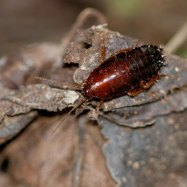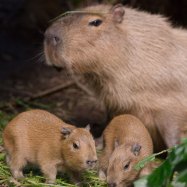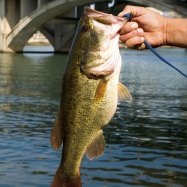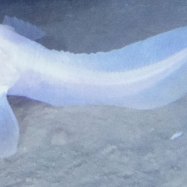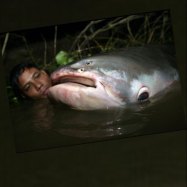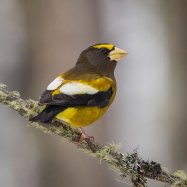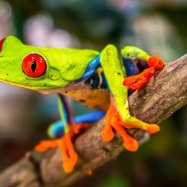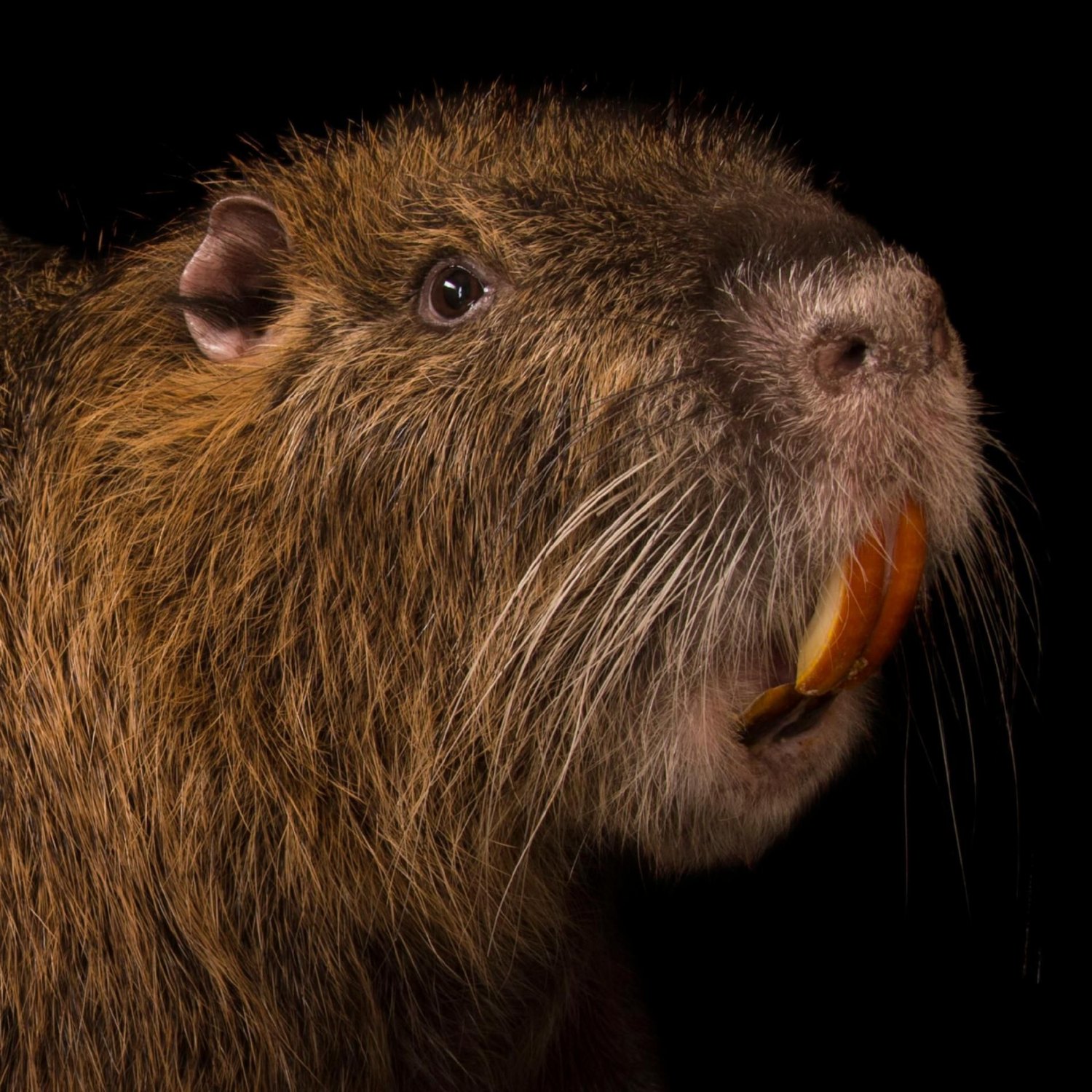
Nutria
17-25 inches (43-64 cm)
Nutria, also known as coypu, are fascinating animals with a large, long-bodied, and cylindrical shape. They can grow up to 25 inches and can be found in many countries such as the US, Canada, Russia, and Europe. These social animals are a popular sight in wetlands and are known for their love of water. #animals #nutria #coypu #wildlife
Animal Details Summary:
Common Name: Nutria
Kingdom: Animalia
Habitat: Marshes, swamps, lakes, rivers
The Fascinating World of the Nutria: An Invasive Species on the Rise
Imagine taking a walk in a serene marshland, surrounded by tall grasses and the peaceful sound of water. Suddenly, you spot a large, brown animal with a long rounded body swimming gracefully through the water. Is it a beaver? A muskrat? No, it is a nutria – a species that is rapidly gaining attention due to its invasive nature.Nutrias, also known by their scientific name Myocastor coypus or common name coypu, are large, aquatic rodents native to South America Nutria. However, due to their desirable fur and their presence in the fur trade, they have been introduced to various countries around the world, leading to their spread and the serious impacts on local ecosystems.
From their unique adaptions to their unpredictable distribution, there is much to explore and discover about these fascinating creatures. So, let's dive into the world of the nutria and learn more about this intriguing species.
Overview and Taxonomy
Like many other animals, nutrias have a scientific name, Myocastor coypus, which helps us understand their taxonomical classification. These creatures belong to the kingdom Animalia, the phylum Chordata, the class Mammalia, and the order Rodentia. They are the largest extant rodent in their family, Myocastoridae, which also includes coypus and pacas.Interestingly, the scientific name Myocastor coypus translates to "mouse beaver" and perfectly describes the physical and behavioral characteristics of these animals.
Habitat and Distribution
Nutrias thrive in aquatic environments such as marshes, swamps, lakes, and rivers. They are excellent swimmers and can stay submerged for up to 5 minutes, making them well-adapted to their watery habitats Narwhal. Their fur is waterproof, and their large, webbed feet enable them to move through the water with ease.Although their country of origin is Argentina, nutrias can now be found in many countries around the world where they have been introduced, including the United States, Canada, Russia, China, and various countries in Europe. They were first brought to the United States in the early 1900s for fur farming, but many escaped or were released into the wild, leading to their exponential growth in numbers.
Nutrias are litter spreaders, meaning that they are capable of quickly reproducing and spreading to new areas. This, combined with their ability to thrive in a variety of habitats, has made them an invasive species in many places, causing harm to native flora and fauna populations.
Feeding and Behavior
Nutrias are herbivorous animals, meaning they primarily feed on vegetation. They have a strong preference for tubers such as cattails, sedges, and water lilies, but they also consume grasses, aquatic plants, and agricultural crops.One of the most distinctive and destructive behaviors of nutrias is their propensity to uproot vegetation from the roots. This is because their digestive systems are not as efficient in breaking down plant matter, so they must consume large amounts to meet their nutritional requirements. As a result, they can cause significant damage to wetland vegetation, leading to soil erosion and loss of habitat for other species.
Nutrias are primarily nocturnal animals, meaning they are most active at night. They are excellent diggers and can create extensive burrow systems to protect themselves from predators and harsh weather conditions.
Physical Characteristics
Nutrias have a unique appearance, making them easy to identify. Their head and body measure around 17-25 inches (43-64 cm) long, and they can weigh anywhere between 10-20 pounds (4.5-9 kg). Their large, long-bodied, and cylindrical shape, along with their short, rounded ears, is reminiscent of a beaver.Their brown fur is thick, dense, and waterproof, with coarse guard hairs and a soft undercoat. This insulation allows them to survive in cold water environments and stay warm during the winter months. Their tail is long, scaly, and hairless, and it makes up about one-fifth of their total body length.
Nutrias have prominent orange-yellow front teeth that continuously grow throughout their lives, like other rodent species. They use these teeth to gnaw on vegetation and to dig burrows. Additionally, their large and slightly webbed hind feet aid in swimming and navigating in their wetland habitat.
The Nutria's Impact on Ecosystems
The introduction of nutrias to new habitats has led to several ecological consequences, making them a cause for concern. One of the most significant impacts is their effect on vegetation. Their voracious appetites and destructive feeding behavior have caused significant loss of vegetation in their introduced range, leading to disruptions in the food chain and a decline in biodiversity.Moreover, their burrowing also causes damage to levees, dams, and other water control structures, leading to potential flooding and property damage. By altering their surrounding environment, nutrias can have long-lasting and detrimental effects on ecosystems that they invade.
The Efforts to Control Nutria Populations
With the growing recognition of the harm caused by nutrias, there have been efforts to reduce and control their populations in various countries. Some methods include trapping, hunting, and the use of contraceptives.Some states in the United States, such as Louisiana, have enacted legislation to encourage the hunting of nutrias for their fur. The state even holds an annual Nutria Fur and Nutria Recipe Cook-off festival to promote their consumption and decrease their numbers.
Furthermore, research is also being conducted to develop more effective control measures, including the use of pheromones to limit nutria reproduction and encourage them to leave an area.
Conclusion: The Ongoing Battle against Nutrias
In conclusion, nutrias are fascinating creatures that have been making headlines in recent years for their invasion of new habitats. They possess unique adaptions that allow them to thrive in aquatic environments, but their introductions to countries worldwide have led to severe ecological consequences.Although efforts are being made to control their populations, the battle against nutrias is ongoing. Their continued spread serves as a reminder of the damaging effects of human interference on the delicate balance of nature and the importance of responsible introduction of species into new environments. The future of nutrias remains uncertain, but with increased awareness and management, we can strive towards mitigating their negative impacts and preserving the ecosystems they invade.

Nutria
Animal Details Nutria - Scientific Name: Myocastor coypus
- Category: Animals N
- Scientific Name: Myocastor coypus
- Common Name: Nutria
- Kingdom: Animalia
- Phylum: Chordata
- Class: Mammalia
- Order: Rodentia
- Family: Myocastoridae
- Habitat: Marshes, swamps, lakes, rivers
- Feeding Method: Herbivorous
- Geographical Distribution: North and South America, Europe, Asia, and Africa
- Country of Origin: Argentina
- Location: Nutrias can be found in many countries around the world where they have been introduced, including the United States, Canada, Russia, China, and various countries in Europe.
- Animal Coloration: Brown
- Body Shape: Large, long-bodied, and cylindrical
- Length: 17-25 inches (43-64 cm)

Nutria
- Adult Size: Adults weigh around 14-20 pounds (6.4-9.1 kg)
- Average Lifespan: 5-10 years
- Reproduction: Nutrias have a high reproductive rate, with females capable of producing multiple litters in a year.
- Reproductive Behavior: Mating occurs throughout the year and can happen both on land and in water.
- Sound or Call: Nutrias make various vocalizations, including whistles, squeals, and grunts, to communicate with each other.
- Migration Pattern: Non-migratory
- Social Groups: Nutrias are generally solitary animals, although they may form small social groups.
- Behavior: Nutrias are semi-aquatic animals, spending most of their time in or near water. They are excellent swimmers and can also dig burrows on land.
- Threats: Hunting, habitat loss, and competition with native species
- Conservation Status: Least Concern
- Impact on Ecosystem: Nutrias can have a negative impact on ecosystems due to their feeding habits and burrowing behavior.
- Human Use: Nutrias are sometimes trapped for their fur and are also used in some countries for meat consumption.
- Distinctive Features: Webbed hind feet, large orange incisors, and a long, scaly tail
- Interesting Facts: Nutrias are also known as coypu. They were introduced to many countries for fur farming but have escaped and established feral populations. Nutrias are excellent swimmers and can stay submerged for up to five minutes.
- Predator: Nutrias have few natural predators, but they can be preyed upon by large birds of prey, alligators, and snakes.
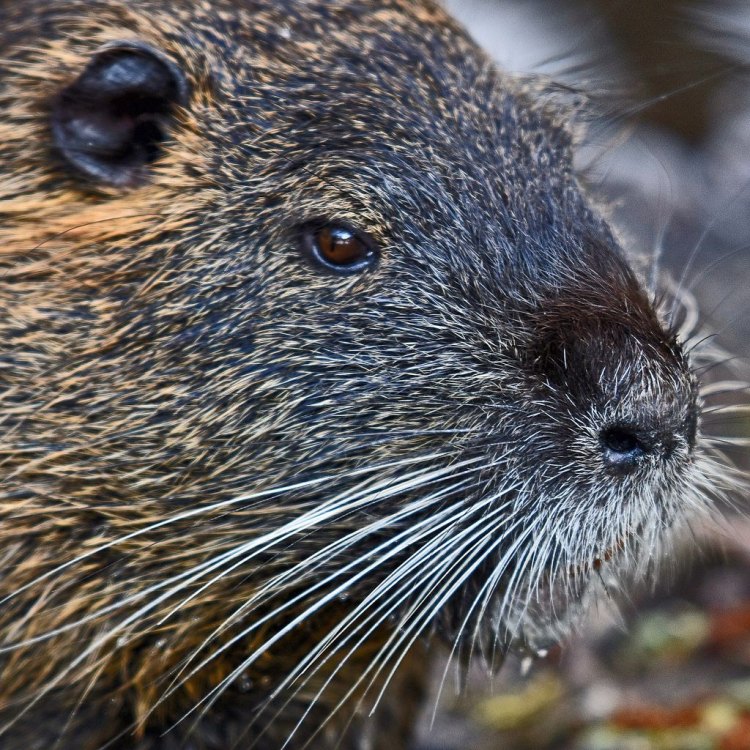
Myocastor coypus
Nutria: The Ecosystem-Shaping Rodent
When you think of rodents, images of small, scurrying creatures may come to mind. But there's one species of rodent that is far from small or inconspicuous – the nutria. These semi-aquatic rodents may not be as well-known as their furry counterparts, but they have unique features and behaviors that make them stand out in the animal kingdom.Nutria, also known as coypu, are large rodents native to South America PeaceOfAnimals.Com. They have been introduced to many other countries for fur farming, but unfortunately, many have escaped and established feral populations. With their distinctive features and interesting behaviors, nutria have become a topic of curiosity and study for many researchers. In this article, we will delve into the world of nutria and discover what makes them such fascinating creatures.
Adult Size and Average Lifespan
One of the most noticeable features of nutria is their size. Adults can weigh anywhere between 14-20 pounds (6.4-9.1 kg) and can reach up to 2 feet in length. This makes them one of the largest rodents in the world. Nutria also have a relatively long lifespan, with an average of 5-10 years in the wild Norfolk Terrier.
Reproduction and Reproductive Behavior
Nutrias have a unique reproductive rate, with females capable of producing multiple litters in a year. They are also known for their high fecundity, meaning they can produce a large number of offspring. This is an adaptation that allows them to quickly replenish their numbers, as they face constant threats from hunting and habitat loss.
Their mating behavior is also quite interesting, as it can occur throughout the year and in both water and land. Nutria are semi-aquatic animals, and therefore, mating on land or water is not a problem for them. This behavior is advantageous as it allows them to adapt to changing environmental conditions.
Sound or Call
Another feature that sets nutria apart from other rodents is their vocalizations. They make various sounds, including whistles, squeals, and grunts, to communicate with each other. These vocalizations are essential in their solitary lifestyle, as it allows them to locate and communicate with other nutria in their territory.
Migration Pattern and Social Groups
Nutria are non-migratory animals, meaning they do not undertake long-distance travels. Instead, they remain in a specific area, usually near a body of water, throughout their lives. They are also generally solitary animals, although they may form small social groups. These groups usually consist of a male, female, and their offspring. However, even within these social groups, nutria may still maintain their solitary habits and only come together for mating or territorial defense.
Behavior and Adaptations
Nutria are semi-aquatic animals, spending most of their time in or near water. As such, they have several adaptations that allow them to thrive in aquatic environments. Their webbed hind feet, which are a characteristic feature of nutria, are perfect for swimming, and they can quickly move through water with ease. They also have dense fur that helps to insulate them against the cold water temperatures.
Interestingly, nutria are also skilled diggers and can create intricate burrow systems. These burrows serve as shelter and protection from predators, as well as a place to raise their young. While they primarily live near water, their burrow systems can extend far into the surrounding land. This behavior is beneficial, as it allows them to adapt to different environments and escape harsh weather conditions.
Threats and Conservation Status
Unfortunately, nutria face numerous threats in the wild. One of the main threats is hunting for their fur, which is considered one of the softest and most luxurious among all rodents. This has led to a significant decrease in their population in some areas.
Habitat loss is also a major concern for nutria, as wetland areas are being drained and converted for agricultural use. This loss of suitable habitat forces nutria to compete with native species for limited resources, which can have devastating effects on both nutria and the native species.
Despite these threats, the International Union for Conservation of Nature (IUCN) lists nutria as a species of Least Concern. This is due to their widespread distribution and high reproductive rate, which allows them to adapt and recover from population declines quickly. However, continued monitoring and conservation efforts are essential to ensure their long-term survival.
Impact on Ecosystems
As with any species, nutria can have both positive and negative impacts on their surrounding ecosystems. Nutria are herbivorous and primarily feed on aquatic plants, such as cattails and water lilies. In areas where nutria populations are high, they can have a significant impact on vegetation, potentially altering the ecology of wetland areas.
Their burrowing behavior also has the potential to affect ecosystems. By digging burrows, nutria can damage levees, dikes, and other man-made structures, causing flooding and erosion. Their burrowing can also damage natural habitats and disrupt the lives of other animals that inhabit the same area.
Human Use and Interesting Facts
Nutrias are sometimes trapped for their fur and are also used in some countries for meat consumption. Despite their size and reputation, their meat is considered a delicacy by some and is often compared to rabbit or chicken.
Aside from their large size, webbed hind feet, and long, scaly tails, nutria also have some other interesting facts that make them unique. For example, they can hold their breath and stay submerged for up to five minutes, making them excellent divers. They are also known to construct "push-ups," mounds of vegetation that they use as lookouts to spot predators while submerged in the water. Nutria are also known as coypu, a name of Tupi-Guarani origin that translates to "water rodent."
Predators
With their large size and aquatic capabilities, nutria have few natural predators. However, they can be preyed upon by large birds of prey, such as eagles and hawks, alligators, and snakes. These predators are mainly a threat to juvenile nutria, as adults are often too large and difficult to catch.
In conclusion, nutria are more than just large rodents – they are fascinating creatures with unique features and behaviors that allow them to thrive in their environment. While they face numerous threats, their adaptable nature and high reproductive rate have allowed them to maintain stable populations in many areas. As with any animal, it is essential to balance human use and conservation efforts to ensure that these ecosystem-shaping rodents continue to thrive in the wild. Next time you spot a nutria, take a moment to appreciate its remarkable adaptations and the important role it plays in its ecosystem.

The Fascinating World of the Nutria: An Invasive Species on the Rise
Disclaimer: The content provided is for informational purposes only. We cannot guarantee the accuracy of the information on this page 100%. All information provided here may change without prior notice.

